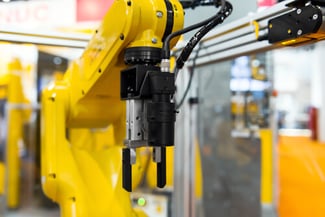Companies always approach capital expenditures with great care, but especially now as the COVID-19 pandemic continues. While we think this is actually a good time to invest in automation, we understand it might feel risky in this time of uncertainty and changing markets.
It may be helpful to think about automation as an investment in flexibility. That can refer to the equipment, the diversity of your product offerings, core capabilities, and your employees. In this blog we take a closer look at each of these.
The Equipment
There are so many options for manufacturing automation – from a single machine to a fully automated factory, and almost every point in between. There’s no one-size-fits-all requirement – it’s very possible to incorporate automation and robotics where and how you want to, so keep these points in mind as you’re starting out:
Be Strategic About ROI

Return on investment (ROI) is what “sells” manufacturers on automation, and the key to ROI is using the equipment as much as possible. A system that is up and running quickly and that stays productive for long stretches will facilitate earning back that initial outlay.
ROI is related to more than just production volume. Some other strategic ROI factors include:
- Purchasing equipment that’s less expensive
- Systems requiring less training or reskilling
- Equipment that’s easier to install or integrate into a process
- Focusing on areas where automation has a substantial impact on product quality
Even after you recoup the cost of the equipment, savings continues as long as you use it, adding to your profits and ability to expand automation. For example, if your hourly production rate increases, the outcome might be higher sales or the ability to fill larger orders. As a result, your revenue increases, which helps directly offset the cost of new equipment and accompanying expenses.
Flexible and Multi-function Technology Expands Options
Some automated machines are “fixed” and only do a single task. This is helpful if you regularly produce a high-volume of a specific component. But technology advances are making flexible automation more common, which means you’ll boost uptime and ROI by using the same equipment for multiple jobs. In many cases, changeover is easy or even automated, so that operators can switch tasks or products without long periods of offline time.
Some examples include:
- Hand-guiding technology to “teach” a robot arm how to perform new tasks as needed
- Sensors that gather information about the environment or part and adjust the machine’s response accordingly
- Grippers that can pick up and manipulate a wide variety of items (e.g. varied shapes, textures, sizes)
- End-of-arm-tools that can be swapped to accommodate changing tasks (e.g. trimming, picking up items, unloading pallets)
It Doesn’t Have To Be All Or Nothing
If you spend any time reading about robotics online, it’s easy to become swept away by images of sleek modern factories staffed entirely with robots. However, that’s not realistic for the majority of manufacturers. It’s far more common to install robots and automation equipment selectively for the specific tasks where they bring the most value. Mixing manual and automated work like this is possible thanks to on-board safety equipment that makes it safe for workers to be in same vicinity.
Production and Capabilities

Is there a precise turning point at which it is always worth it to automate a task or process? Not really. It depends on several factors including variation in the parts you produce, volume and how much that volume changes over time, your interest in diversifying what you produce in the future, and more.
Humans can adapt easily to changing production and tasks, but they are not as fast as machines and are more prone to errors, especially at the end of a long shift. So at a certain point, it might be cost effective to spend the money on a robot or automated work cell that can do the task. On the other hand, a contract manufacturer that rarely runs more than 10,000 units per customer might choose to stick with human workers or invest in highly flexible collaborative robots.
Whether you’re adding equipment to a very specific task or overhauling an entire manufacturing process, new automation brings the opportunity for change. Gains in part quality and consistency and in efficiency free up time, labor, and existing equipment. These can be pivoted to new opportunities, products, or services. Take some time to think about what you want your business to look like. Are you looking for a narrow scope or specialized production? Contract manufacturing or prototyping? Low mix or high volume? Adding a new process or service?
Depending on the current situation, automation can make changes like these (and others) possible:
- High-volume pick and place, sorting, or packaging
- Automated simple or repetitive welding
- Reductions in scrap/rework time and wasted materials
- Potential reduced liability risk for safety-critical parts (e.g. a properly adjusted machine can meet specs with the same amount of materials on each part)
- Consolidate space for large processes like packaging or assembly lines
Use Data To Enhance Operations
Most robots and integrated systems have onboard data collection and analytics so you can track patterns of use, machine parameters, use of consumables, and general “asset health” (e.g. temperature, pressure, oil levels). Keeping an eye on these lets you build preventive maintenance into your production schedule and reduce unplanned work stoppages. You’ll also extend the useful life of the equipment by catching problems as soon as they arise.
Your Employees
A common fear is that robotics and automation take jobs from human workers. In our experience though, most companies are looking for ways to improve employees’ productivity, solve ergonomic and safety challenges, and make work more interesting.
Work and Opportunities Change
Automation can present new possibilities for employees, for example:
- Making tasks physically easier or accessible for aging workers and those with physical disabilities/limitations
- Safety and ergonomics features reduce injury risk on traditionally “dirty and dangerous” work like welding
- Workers can be reassigned from repetitive or monotonous jobs to more skilled or demanding tasks
- Higher-level work, like overseeing a bank of robots and troubleshooting and critical thinking, can replace tedious and low-skilled activities
Compare Labor and Automation Costs

Several of the expenses associated with labor can be reduced as a result of automation and robotics solutions, including:
- Wages
- Paid time off/sick leave
- Training expenses for manual processes
- Hiring, HR administration, and onboarding
What’s more, because most integrated automation systems and equipment is designed for ease-of-use, you can redistribute your existing staff to make best use of the skill sets they have.
While labor costs are ongoing, a majority of the costs associated with a robot or automated work cell are one-time expenditures, such as:
- Equipment (robotics, conveyors, grippers, sensors, tables/carts, structure of the work cell)
- Design and integration (engineering, programming, drawings)
- Facility preparation and installation (utilities, physical space, troubleshooting, run off testing)
There are some ongoing expenses like training, machine consumables (like weld wire or gases, which may increase if machines are faster), and software upgrades. Some of these are periodic unlike large and consistent labor expenses.
The most important thing to remember when comparing expenses is that once you achieve ROI, the production increases and labor cost savings going forward count toward profit.
No two facilities have the same production goals, challenges, or resources. Your application, workforce, and budget determine the equipment and set up, and how extensive it is. Where can automation take your business? Let’s talk about your options – please contact us!



